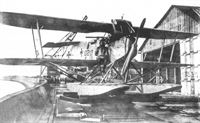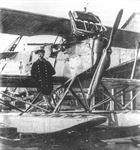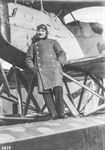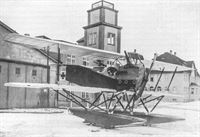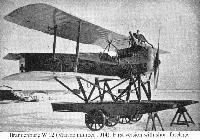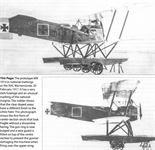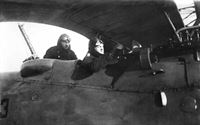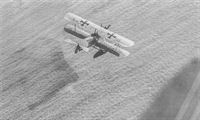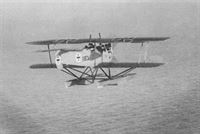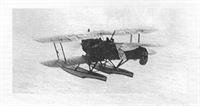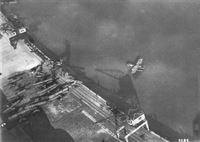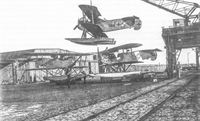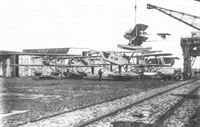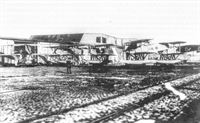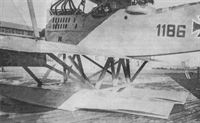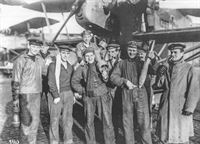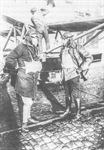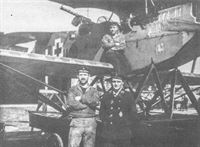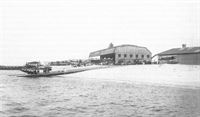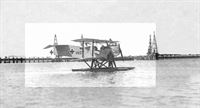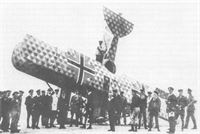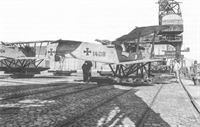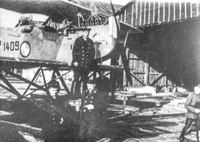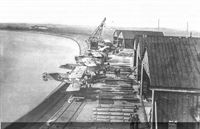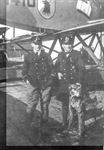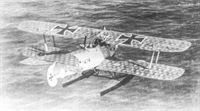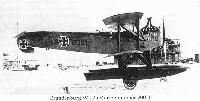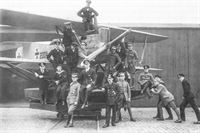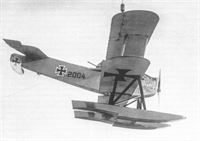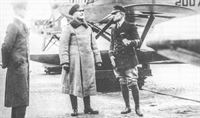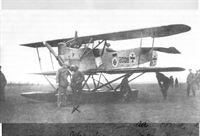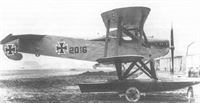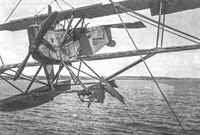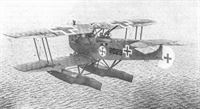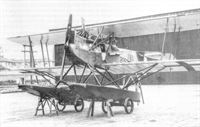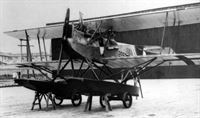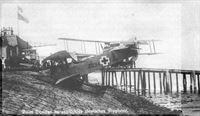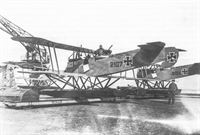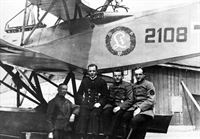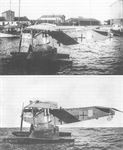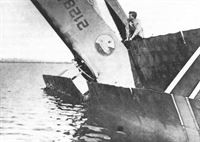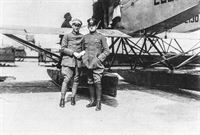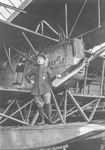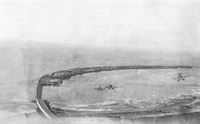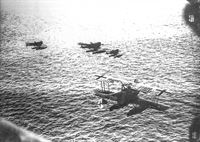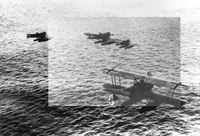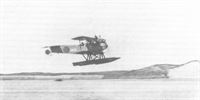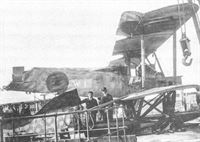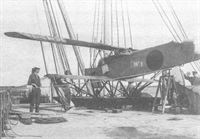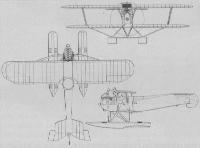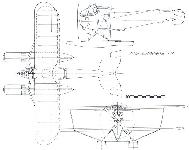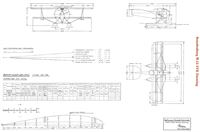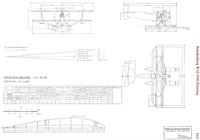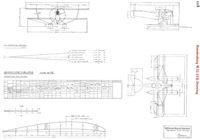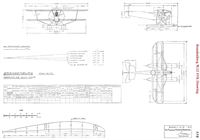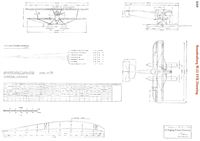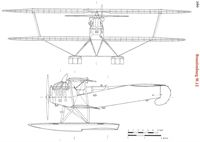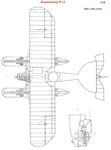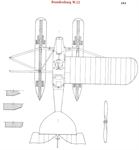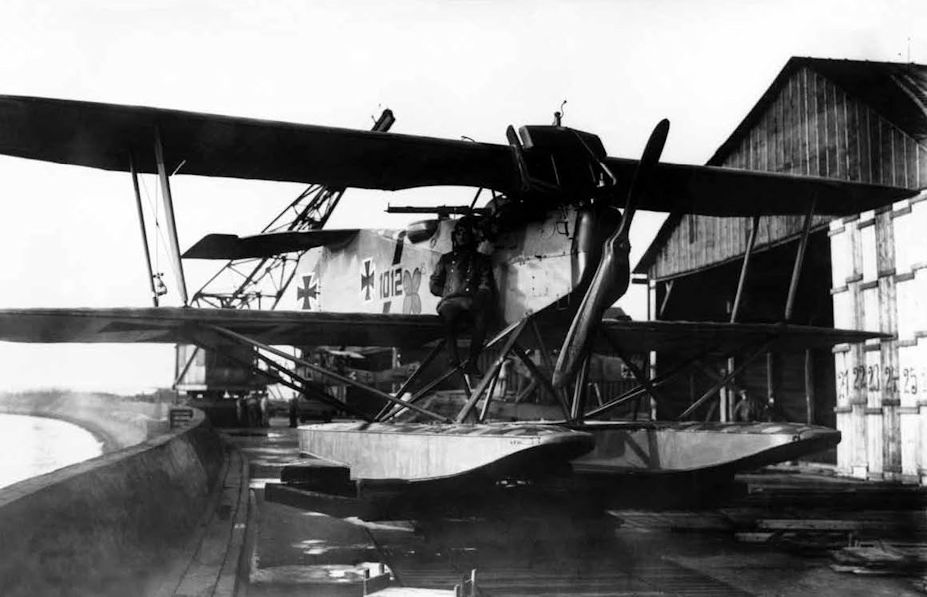
Описание
Страна: Германия
Год: 1917
Two-seat fighter seaplane
Варианты
- Hansa-Brandenburg - W.12 - 1917 - Германия
- Hansa-Brandenburg - W.19 - 1918 - Германия
- Hansa-Brandenburg - W.27 / W.32 - 1918 - Германия
- В.Обухович, А.Никифоров Самолеты Первой Мировой войны
- O.Thetford, P.Gray German Aircraft of the First World War (Putnam)
- W.Green, G.Swanborough The Complete Book of Fighters
- J.Herris German Seaplane Fighters of WWI (A Centennial Perspective on Great War Airplanes 2)
- C.Owers Hansa-Brandenburg Aircraft of WWI Vol.2: Biplane Seaplanes (A Centennial Perspective on Great War Airplanes 18)
- M.Dusing German Aviation Industry in WWI. Volume 1 (A Centennial Perspective on Great War Airplanes 84)
-
C.Owers - Hansa-Brandenburg Aircraft of WWI. Volume 2 - Biplane Seaplanes /Centennial Perspective/ (18)
Brandenburg W.12 #1012, Zeebrugge, October 1917
-
C.Owers - Hansa-Brandenburg Aircraft of WWI. Volume 2 - Biplane Seaplanes /Centennial Perspective/ (18)
Brandenburg W.12 #1014 was the prototype and is shown here as photographed at Warnemunde on 20 February 1917 while its fuselage insignia was still being painted.
-
В.Обухович, А.Никифоров - Самолеты Первой Мировой войны
Ганза-Бранденбург W 12
-
C.Owers - Hansa-Brandenburg Aircraft of WWI. Volume 2 - Biplane Seaplanes /Centennial Perspective/ (18)
Brandenburg W.12 Marine Number 1183 of Oblt.d.R. Friedrich Christiansen, OC, Seeflugstation Flandern 1, Zeebrugge, winter 1917/1918.
-
J.Herris - German Seaplane Fighters of WWI /Centennial Perspective/ (2)
Brandenburg W12 #1183 was the personal aircraft of Oblt.z.S. Friedrich Christiansen. Christiansen took command of the Naval Air Station at Zeebrugge in September 1917; his personal insignia was the initial of his last name in a diamond on a white stripe as shown. Otherwise the aircraft was finished according to the naval directive of April 1917.
-
C.Owers - Hansa-Brandenburg Aircraft of WWI. Volume 2 - Biplane Seaplanes /Centennial Perspective/ (18)
Brandenburg W12 Marine Number 1184, Seeflugstation Flandern 1, Zeebrugge, winter 1917/1918.
-
J.Herris - Development of German Warplanes in WWI /Centennial Perspective/ (1)
Brandenburg W12 #1184 is shown in standard late-war naval camouflage. The red/white checkerboard was a personal marking.This aircraft served at the Zeebrugge Naval Air Station.
The Brandenburg W12 was a milestone design that gave Germany a highly effective two-seat naval fighter. This one is in standard finish with a personal marking of a checkerboard on the rear fuselage. -
C.Owers - Hansa-Brandenburg Aircraft of WWI. Volume 2 - Biplane Seaplanes /Centennial Perspective/ (18)
Brandenburg W.12 Marine Number 1407, Seeflugstation Norderney, July 1918.
-
J.Herris - German Seaplane Fighters of WWI /Centennial Perspective/ (2)
Brandenburg W12 #1407 has had its original insignia over-painted to conform with the new insignia standardized on March 30, 1918. The single white stripe on the rear fuselage indicates assignment to a specific naval air station, possibly Borkum.
-
C.Owers - Hansa-Brandenburg Aircraft of WWI. Volume 2 - Biplane Seaplanes /Centennial Perspective/ (18)
Brandenburg W.12 Marine Number 1409, Seeflugstation Flandern 1, Zeebrugge.
-
J.Herris - German Seaplane Fighters of WWI /Centennial Perspective/ (2)
Brandenburg W12 #1409 was finished in the standard late-war naval camouflage with a personal insignia.
-
C.Owers - Hansa-Brandenburg Aircraft of WWI. Volume 2 - Biplane Seaplanes /Centennial Perspective/ (18)
Brandenburg W.12 Marine Number 1410, Seeflugstation Flandern 1, Zeebrugge, February 1918.
-
W.Green, G.Swanborough - The Complete Book of Fighters
This Brandenburg W12 was flown operationally from Zeebrugge in early 1918 by Leutnant Becht of the Imperial German Navy Air Service.
-
C.Owers - Hansa-Brandenburg Aircraft of WWI. Volume 2 - Biplane Seaplanes /Centennial Perspective/ (18)
Brandenburg W.12 Marine Number 1414, Ltn. Becht, Seeflugstation Flandern 1, Zeebrugge, December 1917.
-
J.Herris - German Seaplane Fighters of WWI /Centennial Perspective/ (2)
Brandenburg W12 Marine #1414 was the personal aircraft of Lt. Becht, Zeebrugge naval air station, December 1917. This short-fuselage aircraft is in standard camouflage with Becht's personal insignia of the white stripes with checkerboard.
-
C.Owers - Hansa-Brandenburg Aircraft of WWI. Volume 2 - Biplane Seaplanes /Centennial Perspective/ (18)
Brandenburg W.12 Marine Number 2002, 3 Staffel, Seeflugstation Borkum, December 1917. The crest is that of the city of Bremen, and the insignia style is assumed.
-
J.Herris - German Seaplane Fighters of WWI /Centennial Perspective/ (2)
Brandenburg W12 Marine #2002 is from the first series with the longer fuselage that improved stability. It is in standard camouflage with Bremen's coat of arms (white key on red) as a personal insignia. This aircraft has ailerons on all wings.
-
C.Owers - Hansa-Brandenburg Aircraft of WWI. Volume 2 - Biplane Seaplanes /Centennial Perspective/ (18)
Brandenburg W.12 Marine Number 2008, early 1918.
-
C.Owers - Hansa-Brandenburg Aircraft of WWI. Volume 2 - Biplane Seaplanes /Centennial Perspective/ (18)
Brandenburg W.12 Marine Number 2028, April-May 1918.
-
C.Owers - Hansa-Brandenburg Aircraft of WWI. Volume 2 - Biplane Seaplanes /Centennial Perspective/ (18)
Brandenburg W.12 Marine Number 2052, Seeflugstation Norderney, summer 1918.
-
C.Owers - Hansa-Brandenburg Aircraft of WWI. Volume 2 - Biplane Seaplanes /Centennial Perspective/ (18)
Brandenburg W.12 Marine Number 2096, Staffel 3, Seeflugstation, Borkum, May-June 1918.
-
C.Owers - Hansa-Brandenburg Aircraft of WWI. Volume 2 - Biplane Seaplanes /Centennial Perspective/ (18)
Brandenburg W.12 Marine Number 2098, June 1918.
-
C.Owers - Hansa-Brandenburg Aircraft of WWI. Volume 2 - Biplane Seaplanes /Centennial Perspective/ (18)
Brandenburg W.12 Marine Number 2108, May-June 1918.
-
C.Owers - Hansa-Brandenburg Aircraft of WWI. Volume 2 - Biplane Seaplanes /Centennial Perspective/ (18)
Brandenburg W.12 Marine Number 2118, Ltn. Haase & Vizeflugmaat Goetze, OC Staffel 3, Seeflugstation Borkum, late spring 1918.
-
C.Owers - Hansa-Brandenburg Aircraft of WWI. Volume 2 - Biplane Seaplanes /Centennial Perspective/ (18)
Brandenburg W.12 W1 (ex-2098), Dutch Naval Air Service, 1918.
-
J.Herris - German Seaplane Fighters of WWI /Centennial Perspective/ (2)
W12 Marine #1012, the second pre-production aircraft, is seen here in operational markings at Zeebrugge. As tabulated above, the pre-production aircraft were category C2MG and were powered by the 160 hp Mercedes D.III engine.
-
C.Owers - Hansa-Brandenburg Aircraft of WWI. Volume 2 - Biplane Seaplanes /Centennial Perspective/ (18)
View with crew member posing with MN 1012. Note the dark painted nose, personal emblem and fuselage band. The floats are either covered with the hexagon fabric on their top surface or else painted to match the pre-printed fabric. There is a stencil on the front of the pontoon. These floats are a light color.
-
C.Owers - Hansa-Brandenburg Aircraft of WWI. Volume 2 - Biplane Seaplanes /Centennial Perspective/ (18)
View with crew member posing with MN 1012. Note the dark painted nose, personal emblem and fuselage band. The floats are either covered with the hexagon fabric on their top surface or else painted to match the pre-printed fabric. There is a stencil on the front of the pontoon. These floats are a light color.
-
C.Owers - Hansa-Brandenburg Aircraft of WWI. Volume 2 - Biplane Seaplanes /Centennial Perspective/ (18)
Crewman with a W.12. Note that the cockpit is not bulged on this example.The personal marking appears to be a variation of the four leaf clover (MN 1012?). Note that the hexagon camouflage pattern on the floats carries up and over the batten strips indicating that it must have been painted on. The struts appear to be the light grey color of the fuselage. Note also the marking on the nose of the float. The narrow straight armed cross on the machine in the background indicates that this photograph was taken after April 1918. (AHT AL0354-008)
-
C.Owers - Hansa-Brandenburg Aircraft of WWI. Volume 2 - Biplane Seaplanes /Centennial Perspective/ (18)
The prototype W.12 floatplane prototype MN 1014 in January 1917, outside the Brandenburg factory hangar at Briest.The prototypes differed markedly from the production examples. The pilot's cockpit has a low side to starboard to facilitate entry, and the gun ring is small without the bulged sides for the standard gun ring. Note the light color of the bottom of the pontoons. The synchronised machinegun fitted to the W.12 was the Maxim IMG-08 with its distinctive fat jacket. Later machines carried two guns but the extra weight had a detrimental effect on performance.
-
O.Thetford, P.Gray - German Aircraft of the First World War /Putnam/
Brandenburg W 12 (Marine number 1014). First version with short fuselage
-
C.Owers - Hansa-Brandenburg Aircraft of WWI. Volume 2 - Biplane Seaplanes /Centennial Perspective/ (18)
The prototype MN 1014 in national markings at the SVK, Warnemunde, 20 February 1917. It has a very dark fuselage and an unusual marking of the national insignia. The rudder shows that the clear doped areas have a different finish to the white field. This photograph shows the first form of center-section struts that look fragile without a streamline fairing. The gun ring is now bulged and a wire guard is fitted on top of the centre section to prevent the gunner damaging the machine when firing over the upper wing.
-
C.Owers - Hansa-Brandenburg Aircraft of WWI. Volume 2 - Biplane Seaplanes /Centennial Perspective/ (18)
The prototype MN 1014 in national markings at the SVK, Warnemunde, 20 February 1917.
-
M.Schmeelke - "Torpedo Los!" /Aeronaut/
MN 1180 on the beach has the blue-grey fuselage that allows the markings to stand out. Brandenburg W12 #1180 was one of the escort fighters for Gotha WD11 torpedo bomber attacks in the Baltic in late 1917. (AHT AL0225-27)
-
J.Herris - German Seaplane Fighters of WWI /Centennial Perspective/ (2)
Oblt.z.S. Friedrich Christiansen downed British airship C27; that victory lead to his award of the Pour le Merite. He is shown here with his gunner, Vzfw. Wladika, in W12 #1183, the aircraft he used to destroy C27. W12 #1183 was accepted in September 1917 and served until destroyed in a bombing raid on the Zeebrugge Mole on May 10, 1918.
This photograph illustrates how the upper wing enclosed the pilot making it difficult if not impossible to get out in a hurry in the event of a accident at sea. The bulged surround for the observer's gun ring is well shown. There were at least two different types of gun ring supports used on the W.12. The proximity of the machine guns to the pilot allowed for jambs to be cleared. Later machines had the machine gun partially cowled. -
J.Herris - German Seaplane Fighters of WWI /Centennial Perspective/ (2)
W12s at their base at Zeebrugge. Oblt.z.S. Christiansen's #1183 is in the center.
-
C.Owers - Hansa-Brandenburg Aircraft of WWI. Volume 2 - Biplane Seaplanes /Centennial Perspective/ (18)
Christiansen flying one of the early production Brandenburg W12 seaplanes powered by a 150hp Benz engine. This aircraft, 1183, served at Zeebrugge for eight months before it was destroyed in a bombing attack on the Mole on 10 May 1918. Designed by Ernst Heinkel late in 1916, the W12's performance was equal to that of the single-seat seaplanes then in service. Capable of 160km/hr (100mph), its rate of climb and general manoeuvrability made it popular with the crews, who gave it the name 'Kamel'.
-
C.Owers - Hansa-Brandenburg Aircraft of WWI. Volume 2 - Biplane Seaplanes /Centennial Perspective/ (18)
View of MN 1183 in standard color scheme before Christiansen has added his personal "touches". The hexagon pre-printed fabric to the upper surfaces of wings and tail are well shown. 1183 was Christiansen's mount when he destroyed the British airship C27 on 11 December 1917. Accepted in September 1917 this machine survived until it was destroyed in an air attack on the Zeebrugge Mole on 10 May 1918. The photograph illustrate that from some directions the perception of the national insignia changes and how British airmen could report that the German insignia was painted in a circle. (AHT AL0354-032)
-
C.Owers - Hansa-Brandenburg Aircraft of WWI. Volume 2 - Biplane Seaplanes /Centennial Perspective/ (18)
Ships were important targets. The original caption states that it depicts Ltn. Herrankuchl bombing ship. The machine in the photo is Christiansen's W.12. (AHT AL0087-055)
-
C.Owers - The Fighting America Flying Boats of WWI Vol.2 /Centennial Perspective/ (23)
The cause of it all, the Germans introduction of Brandenburg two-seat fighting floatplanes to the North Sea. The first Brandenburg fighter was the W.12 and it set the standard for those that followed. The raised rear fuselage with the rudder below gave the gunner a superb field of fire. This machine, Marine Number 1183, bears the personal markings of Christensen. (AHT AL0064-13)
-
C.Owers - Hansa-Brandenburg Aircraft of WWI. Volume 2 - Biplane Seaplanes /Centennial Perspective/ (18)
The Mole at Zeebrugge with ten W.12 biplanes on the hardstand area. The machine to the rear and nearest the water appears to be Christiansen's.The W.19 on the water has a white field but it can not be ascertained if this is also a machine with Christiansen's insignia. (AHT AL0444-002 from the album of F. Christiansen)
-
C.Owers - Hansa-Brandenburg Aircraft of WWI. Volume 2 - Biplane Seaplanes /Centennial Perspective/ (18)
A scene on the Mole at Zeebrugge, aircraft of IC Staffel. The "C" in diamond is the personal marking of Christiansen and was to appear on many of his aircraft. The interior of Brandenburg's fuselage was painted white and this is evident on the open pilot's cockpit door. This aircraft has cockpit doors on both sides of the fuselage. MN 1183 has white sides to its pontoons. MN 1184 has a quartered square as its pilot's emblem.The third W.12 is MN 1395 from the second production batch. The crane was used to lift the machines into and out of the water at Zeebrugge. (via AHT AL0087-019)
-
C.Owers - Hansa-Brandenburg Aircraft of WWI. Volume 2 - Biplane Seaplanes /Centennial Perspective/ (18)
More views of Zeebrugge. Christiansen's 1183 is identified by its insignia. MNs 1395 and 1396 may be identified on the original print. Note that the machine suspended in the air had a man in the rear cockpit and the metal engine panels removed. These machines all have the nose radiator. According to CF Snowden Gamble (The Story of a North Sea Air Station), the Germans had converted the railway sheds on the Mole into a seaplane station and kept their machines when not in use on railway trucks with a locomotive standing by, always with steam up, to move them to safety whenever enemy bombing forces were detected approaching, (via AHT AL0064-08)
-
C.Owers - Hansa-Brandenburg Aircraft of WWI. Volume 2 - Biplane Seaplanes /Centennial Perspective/ (18)
MN 1186 is in standard color scheme with the top of the floats covered in the hexagon camouflage pattern. This was the first W.12 at Borkum. During firing trials of the synchronised gun it shot the propeller off and the engine tore out of its mounting but the crew managed to effect a safe forced landing.
-
C.Owers - Hansa-Brandenburg Aircraft of WWI. Volume 2 - Biplane Seaplanes /Centennial Perspective/ (18)
Ground crew pose with the bombs. The W.12 was never equipped to carry bombs. MN 1393 in background.
-
A.Imrie - German Naval Air Service /Arms & Armour/
Carrier-pigeons formed an important part of the equipment of seaplanes. The birds were released with position information if a machine was forced to land on the water, and many crews and aircraft were saved as a result. While Brandenburg W12 1399 at Zeebrugge is bombed-up prior to flight, pigeons are checked into their special wicker basket for stowing on board.
-
C.Owers - Hansa-Brandenburg Aircraft of WWI. Volume 2 - Biplane Seaplanes /Centennial Perspective/ (18)
This crew from II.C Staffel display the WWI life vests, 29 February 1918. The W.12 in the background is MN 1399. The machine gun on the port side may be made out on the original photograph. This machine was produced with only a synchronised machine gun on the starboard side and was therefore modified in service.
-
C.Owers - Hansa-Brandenburg Aircraft of WWI. Volume 2 - Biplane Seaplanes /Centennial Perspective/ (18)
MN 1400 bears the thick interim cross national marking. Note the dark square behind the fuselage cross. The scaffolding support is in front of what must be a personal emblem.
-
C.Owers - Hansa-Brandenburg Aircraft of WWI. Volume 2 - Biplane Seaplanes /Centennial Perspective/ (18)
MN 1401 in flight above a sea of clouds.
-
C.Owers - Hansa-Brandenburg Aircraft of WWI. Volume 2 - Biplane Seaplanes /Centennial Perspective/ (18)
The Friedrichshafen floatplane on the end of the slipway has not had the lower wing crosses modified to the interim standard. There are two Brandenburg W.12 biplanes amongst these reconnaissance Friedrichshafens. MN 1403 is to the left and has only the fuselage crosses altered. MN 1401 on the right is presumed to be the same. (AHT AL0650-002)
Другие самолёты на фотографии: Friedrichshafen FF33 - Германия - 1915
-
C.Owers - Hansa-Brandenburg Aircraft of WWI. Volume 2 - Biplane Seaplanes /Centennial Perspective/ (18)
Marine #1407, a Brandenburg W12 of the second production batch, illustrates the distinctive features of this breakthrough design, including the upswept tail without vertical fin that gave the gunner an excellent field of fire. The extensive keel surface provided by the deep rear fuselage eliminated the need for a fin. To reduce drag the radiator has been moved to the nose. Both doors on the pilot's cockpit are open to allow easier access.
MN 1407 in harbor with the crewman waiting patiently on the pontoon. This machine features the thick interim national cross marking. The rudder is now completely doped white with the cross marked thereon. The white internal fuselage color is displayed on the open cockpit door. (AHT AL0225-28) -
C.Owers - Hansa-Brandenburg Aircraft of WWI. Volume 2 - Biplane Seaplanes /Centennial Perspective/ (18)
A pilot's error always created a gathering for the camera. Compare MN 1407's markings with the photograph above.The early curved cross national markings over-painted and the final narrow cross applied. A narrow band has been applied to the rear fuselage. The lower wings appear to have been crudely over-painted white to eliminate the early cross.
-
C.Owers - Hansa-Brandenburg Aircraft of WWI. Volume 2 - Biplane Seaplanes /Centennial Perspective/ (18)
W12 Marine #1407 of the second production batch in an embarrassing position. Its original insignia have been over-painted in the new insignia standardized on March 30, 1918. The single white stripe on the rear fuselage indicates assignment to a specific naval air station, possibly Borkum.
-
C.Owers - Hansa-Brandenburg Aircraft of WWI. Volume 2 - Biplane Seaplanes /Centennial Perspective/ (18)
Three W.12 floatplanes on the Zeebrugge docks, 1918. The floats appear to be painted with black bitumen paint. (AHT AL03354-015)
-
C.Owers - Hansa-Brandenburg Aircraft of WWI. Volume 2 - Biplane Seaplanes /Centennial Perspective/ (18)
MN 1409 has a distinctive emblem marked forward of the Marine Number. Accepted during the period 16-30 November 1917, this biplane lasted until written off on 6 May 1918. The crew's personal insignia is on the side of the observer's cockpit. Unfortunately, their names are not known.
-
C.Owers - Hansa-Brandenburg Aircraft of WWI. Volume 2 - Biplane Seaplanes /Centennial Perspective/ (18)
Marine #1409 is first in this lineup of W12 fighters at Zeebrugge Naval Air Station on the Flanders coast.
-
C.Owers - Hansa-Brandenburg Aircraft of WWI. Volume 2 - Biplane Seaplanes /Centennial Perspective/ (18)
The naval units also had their dogs! Two officers pose in front of MN 1410 that has a heraldic-type emblem. The open cockpit door displays the internal white color. It was photographed with several crew members on February 6, 1918. Entering service in the period 16-30 November 1917, it was written off on 23 April 1918.
-
C.Owers - Hansa-Brandenburg Aircraft of WWI. Volume 2 - Biplane Seaplanes /Centennial Perspective/ (18)
Zeebrugge W.12 floatplanes taking off. The leading machine is MN 1414 judging by the checkerboard personal insignia. 1414 was the aircraft of Ltn.d.Reserve Bechl, the commander of IIC Staffel at Zeebrugge. Note the prominent way the white outline for the wing crosses stand out. (AHT AL0087-038)
-
C.Owers - Hansa-Brandenburg Aircraft of WWI. Volume 2 - Biplane Seaplanes /Centennial Perspective/ (18)
Famous photograph of MN 1414 in flight showing the hexagonal camouflage applied to upper surfaces. Preprinted fabric was used; however, it is thought that early applications of this scheme may have been hand painted, but confirmation is lacking. The sides and presumably the bottoms of the floats are black bituminous paint. 1414 was originally going to be shipped to Turkey but instead was sent to Zeebrugge.The German Navy's specifications stated that the wing crosses had to be positioned at the tips of the wings; however, Brandenburg painted them in the same locations as it would for aircraft delivered to the Austro-Hungarians. 1414 was severely damaged in a bombing raid by No.211 Squadron, RAF, during the summer of 1918, that damaged other machines from 3C Staffel.
-
O.Thetford, P.Gray - German Aircraft of the First World War /Putnam/
Brandenburg W 12 (Marine number 2001).
-
C.Owers - Hansa-Brandenburg Aircraft of WWI. Volume 2 - Biplane Seaplanes /Centennial Perspective/ (18)
Some serious and some playful posing around MN 2004. The men in the group photo are the pilots of Seeflugstation Flanders I, abbreviated See I, in late 1917. Christiansen is sitting on the pontoon just under the prop. 27 January 1918. The change to the center section struts and partially-cowled machine gun are noteworthy. W12 #2004, a category C2MG, has the longer fuselage plus a nose radiator for its Benz Bz.III. It is.
-
C.Owers - Hansa-Brandenburg Aircraft of WWI. Volume 2 - Biplane Seaplanes /Centennial Perspective/ (18)
Suspended in the air MN 2004 shows how the darker upper surface finish joined with the light colored (clear doped) lower surfaces. No white outline is applied to the crosses. The floats have a shiny appearance indicating that they are clear varnished on this example. Floats were replaced regularly. Metal floats were developed and would have been in widespread use if the war had continued.
German Naval pilots did not like the flying boat format for use in the English Channel, North Sea, and Baltic Sea theatre of operations. They preferred the twin-float seaplane format and the two-seat Hansa-Brandenburg W.12, seen here, was one of the best. It’s performance gave German crews a huge advantage against the lumbering Felixstowe and Short aircraft of the British. -
C.Owers - Hansa-Brandenburg Aircraft of WWI. Volume 2 - Biplane Seaplanes /Centennial Perspective/ (18)
Christiansen in discussion with other officers.The W.12 behind them, MN 2007, has a white field to the underwing curved cross. The floats and struts appear to be black.
-
C.Owers - Hansa-Brandenburg Aircraft of WWI. Volume 2 - Biplane Seaplanes /Centennial Perspective/ (18)
Germany's single-seat floatplane fighters were reasonably successful defending German naval air stations, but longer-range fighters of greater combat effectiveness were needed for offensive operations. The two-seat Brandenburg W12 fighter succeeded brilliantly and immediately became a problem for Allied flying boats over the North Sea. The innovative W12 set the pace for subsequent two-seat floatplane fighters and its monoplane derivatives served into the mid-1930s. The four-leaf clover on the fuselage of this W12 worked; this crew is happy to survive a forced landing on a grassy field. The W12 was a sturdy warplane and this aircraft turned out to be almost undamaged by its experience.
The fuselage and rudder cross have a white outline.
The Brandenburg W12 shows its innovative tail design that gave the gunner a nearly unobstructed field of fire to the rear. The gunner could also fire forward over the wing or between the wings. The floats were strong enough to tolerate emergency landings on land. -
C.Owers - Hansa-Brandenburg Aircraft of WWI. Volume 2 - Biplane Seaplanes /Centennial Perspective/ (18)
MN 2016 with a 195-hp Benz Bz.IIIb V-8 engine, 14 March 1918. V-eight engine installed for testing. This machine has all the modifications to date including four ailerons, large cut-out in the upper wing center, and longer fuselage. Points to note are the stencil on the nose of the float; the dark color of the struts; the fuel leads from the upper wing gravity tank, and the application of the national insignia with white outline. In the hangars in the background are a set of huge wings. MN 2016 served at the SVK till the war's end but was never formally accepted by the Navy.
-
C.Owers - Hansa-Brandenburg Aircraft of WWI. Volume 2 - Biplane Seaplanes /Centennial Perspective/ (18)
MN 2016 with a 195-hp Benz Bz.IIIb V-8 engine, 14 March 1918. V-eight engine installed for testing. This machine has all the modifications to date including four ailerons, large cut-out in the upper wing center, and longer fuselage. Points to note are the stencil on the nose of the float; the dark color of the struts; the fuel leads from the upper wing gravity tank, and the application of the national insignia with white outline. MN 2112 appears in the background. MN 2016 served at the SVK till the war's end but was never formally accepted by the Navy.
-
C.Owers - Hansa-Brandenburg Aircraft of WWI. Volume 2 - Biplane Seaplanes /Centennial Perspective/ (18)
Pontoons suffered from rough sea conditions and were really only suitable for sheltered waters. MN 2017 has suffered a major accident but appears to be in good shape apart from the smashed pontoon. It is finished with the late narrow crosses without any sign of over-painting. (AHT AL0354-018)
-
C.Owers - Hansa-Brandenburg Aircraft of WWI. Volume 2 - Biplane Seaplanes /Centennial Perspective/ (18)
The swastika on MN 2028 off Ostende in 1918 denotes good luck and was a common symbol used by both sides in WWI. The crosses are in the interim style and have a "fat" appearance on the wings. (AHT AL0057-03)
-
C.Owers - Hansa-Brandenburg Aircraft of WWI. Volume 2 - Biplane Seaplanes /Centennial Perspective/ (18)
MN 2053 with frontal radiator carries the final form of national marking. The lower wing crosses do not have a white outline, the rudder is white and the machine carries the two tail bands indicating a machine from the resort island of Norderney. Note the racks under the rear cockpit presumably for flares. Floats and struts are a dark color (black).
-
J.Herris - German Seaplane Fighters of WWI /Centennial Perspective/ (2)
Marine #2052, a Brandenburg W12 of the fourth production batch, has a nose radiator and ailerons on all wings, with upper and lower ailerons connected by an actuating strut. It also mounted two fixed machine guns for the pilot in addition to the observer's flexible gun, making it a category C3MG. The outer portion of the propeller leading edge was covered with metal to reduce erosion from water spray.
Disappointed with the operational limitations of its single-seat floatplane fighters, which could intercept opposing reconnaissance airplanes but could not undertake longer-range offensive operations or compete with land-based fighters, the German Navy requested two-seat floatplane fighters. The innovative Brandenburg W12 was a breakthrough two-seat floatplane fighter design. Its clever integration of float bracing struts nearly eliminated the need for drag-producing bracing wires. More important, the W12 had the speed and maneuverability of the similarly-powered single-seat floatplanes coupled with the great advantage of a gunner with flexible gun and longer range. The W12 fought very effectively over the North Sea against British flying boats on antisubmarine operations and made such an impact that it inspired all subsequent German floatplane fighter designs. -
C.Owers - Hansa-Brandenburg Aircraft of WWI. Volume 2 - Biplane Seaplanes /Centennial Perspective/ (18)
A hard landing for MN 2094! It appears that the machine taxied into the seawall between the Helgoland launching ramps. Note the Friedrichshafen FF 49C biplanes in the background and the wooden wharf/slipway. Staffel number 3 is just behind the interim national insignia. There is an individual emblem on the rear fuselage of MN 2094. It lacks detail and may be the background for a detail emblem that has not been painted yet, or over-painting of a previous emblem. This machine had the early curved wing crosses at the time of this accident.
Другие самолёты на фотографии: Friedrichshafen FF49 - Германия - 1917
-
C.Owers - Hansa-Brandenburg Aircraft of WWI. Volume 2 - Biplane Seaplanes /Centennial Perspective/ (18)
Four W.12 floatplanes can be seen in this Zeebrugge scene. The observer is standing in the cockpit of MN 2107 gives a good idea of where the floor was located. A sight for the single synchronised machine gun can be seen as well as the open cockpit door. The tailplane from MN 2001 was of a less rounded and more rectangular shape. There were at least three variations to the tailplane. MN 2104 in the background is finished in the same color scheme. (AHT AL0354-020)
-
J.Herris - German Seaplane Fighters of WWI /Centennial Perspective/ (2)
Army and Navy airmen and ground crew pose with MN 2108. The German Army assigned aircrew to the Navy to learn how to navigate over water, accounting for their presence in the photograph. There is a wealth of detail to be seen in this photograph. Note the personal insignia; the late narrow cross on the fuselage; the rack for flare cartridges under the gun ring; the bulged cockpit that was introduced to give the pilot more room; the rack on the upper wing center section, possibly as a guide for the gunner to avoid damaging his own machine; lack of a synchronised machine gun on the port side; and plumbing from the wing-mounted radiator of the Mercedes engine. The LVG gun ring was copied from the British Scarff-type ring.
-
C.Owers - Hansa-Brandenburg Aircraft of WWI. Volume 2 - Biplane Seaplanes /Centennial Perspective/ (18)
These two photographs of MN 2119 from 3 Staffel are reproduced as the below photograph is taken from a wartime British publication on German aircraft. The background has been eliminated to define the shape of the machine and, perhaps by the intelligence services (German or Allied?) to conceal the location or information about the source of the image. The personal emblem is a rampant stallion. The late cross national markings on the fuselage and rudder show where the earlier crosses have been over-painted. This machine has the wing-mounted radiator.
-
C.Owers - Hansa-Brandenburg Aircraft of WWI. Volume 2 - Biplane Seaplanes /Centennial Perspective/ (18)
This type of accident was common with floatplanes. MN 2128 has the late narrow crosses. There is a belt for flare cartridges under the gun ring.
-
C.Owers - Hansa-Brandenburg Aircraft of WWI. Volume 3 - Monoplane Seaplanes /Centennial Perspective/ (19)
Officers Stormer and Sonsalla pose with a W.29 as background. Note that the weighted radio aerial falls outside on the starboard side of the fuselage and not through the floor. The dark color of the floats is probably due to their finish of bituminous waterproofing paint.The machine to the right is MN 2130.
Другие самолёты на фотографии: Hansa-Brandenburg W.29 - Германия - 1918
-
C.Owers - Hansa-Brandenburg Aircraft of WWI. Volume 2 - Biplane Seaplanes /Centennial Perspective/ (18)
Note the pilot badge on this crewman. Frontal radiator and exhaust to port indicates a Benz-engined Brandenburg W.12. Also noteworthy are the propeller and windscreen detail. The floats and struts appear to be the same blue-grey as the fuselage. (AHT AL0354-012)
-
C.Owers - Hansa-Brandenburg Aircraft of WWI. Volume 2 - Biplane Seaplanes /Centennial Perspective/ (18)
A Brandenburg W.29 monoplane leads two W.12 biplanes off from Zeebrugge. The W.29, MN 2209(7), bears the interim national markings while the W.12 biplanes show the interim crosses marked on an all white rudder and white panel on the fuselage. No white can be detected on the wings of the nearest W.12, MN 2037, the crosses having no outline. (AHT AL0064-08A)
Другие самолёты на фотографии: Hansa-Brandenburg W.29 - Германия - 1918
-
C.Owers - Hansa-Brandenburg Aircraft of WWI. Volume 2 - Biplane Seaplanes /Centennial Perspective/ (18)
W.12 in flight over the sea wall at Zeebrugge. Note the bridge over the "blasting gap." (AHT AL0087-046)
-
C.Owers - Hansa-Brandenburg Aircraft of WWI. Volume 3 - Monoplane Seaplanes /Centennial Perspective/ (19)
Brandenburg W.12 biplane inflight with W.29 monoplanes, (via AHT AL0354-068)
Другие самолёты на фотографии: Hansa-Brandenburg W.29 - Германия - 1918
-
C.Owers - Hansa-Brandenburg Aircraft of WWI. Volume 3 - Monoplane Seaplanes /Centennial Perspective/ (19)
W.29 monoplanes on patrol with a Brandenburg W.12. The W.29 and W.12 machines have all had their large interim type crosses painted out and the final narrow crosses painted over. On the original print the grey over-painting may be made out.
Другие самолёты на фотографии: Hansa-Brandenburg W.29 - Германия - 1918
-
C.Owers - Hansa-Brandenburg Aircraft of WWI. Volume 2 - Biplane Seaplanes /Centennial Perspective/ (18)
Brandenburg monoplanes and biplanes often flew sorties together. Note how the old wing crosses have been altered to the late narrow type in a more refined manner on the W.12's wings compared with the W.29. (AHT AL0588-015)
Другие самолёты на фотографии: Hansa-Brandenburg W.29 - Германия - 1918
-
C.Owers - Hansa-Brandenburg Aircraft of WWI. Volume 2 - Biplane Seaplanes /Centennial Perspective/ (18)
After being interned in the Netherlands MN 2098 was purchased for Hf 25.000 and taken over by the Dutch Navy's aerial arm, the MLD, under the serial W 1. The German national markings were over-painted with the Dutch orange circle marking.
-
C.Owers - Hansa-Brandenburg Aircraft of WWI. Volume 2 - Biplane Seaplanes /Centennial Perspective/ (18)
A view of W 1 after its demise. The Dutch orange national insignia was marked on the lower surface of each wing, a common practice for Netherlands aircraft.
-
C.Owers - Hansa-Brandenburg Aircraft of WWI. Volume 2 - Biplane Seaplanes /Centennial Perspective/ (18)
The end of W 1 occurred when alighting at De Mok. The rib tapes on the ailerons over the hexagon fabric show up in this view.
-
J.Herris - German Seaplane Fighters of WWI /Centennial Perspective/ (2)
Другие самолёты на фотографии: Felixstowe F.2 - F.5 - Великобритания - 1917
-
J.Herris - German Seaplane Fighters of WWI /Centennial Perspective/ (2)
The combat effectiveness of the new Brandenburg W12 two-seat fighter immediately rendered all other floatplane fighters obsolete. All subsequent production floatplane fighters were developed from the W12. Here a pair of W12 fighters escort a U-Boat into harbor on the Flanders coast.
-
C.Owers - Hansa-Brandenburg Aircraft of WWI. Volume 2 - Biplane Seaplanes /Centennial Perspective/ (18)
Brandenburg W.12 SVK Drawing
-
C.Owers - Hansa-Brandenburg Aircraft of WWI. Volume 2 - Biplane Seaplanes /Centennial Perspective/ (18)
Brandenburg W.12 SVK Drawing
-
C.Owers - Hansa-Brandenburg Aircraft of WWI. Volume 2 - Biplane Seaplanes /Centennial Perspective/ (18)
Brandenburg W.12 SVK Drawing
-
C.Owers - Hansa-Brandenburg Aircraft of WWI. Volume 2 - Biplane Seaplanes /Centennial Perspective/ (18)
Brandenburg W.12 SVK Drawing
-
C.Owers - Hansa-Brandenburg Aircraft of WWI. Volume 2 - Biplane Seaplanes /Centennial Perspective/ (18)
Brandenburg W.12 SVK Drawing
-
C.Owers - Hansa-Brandenburg Aircraft of WWI. Volume 2 - Biplane Seaplanes /Centennial Perspective/ (18)
Brandenburg W.12 MN 1395 - 1414
В.Обухович, А.Никифоров Самолеты Первой Мировой войны
В начале 1917 г. авиаконструктор Э. Хейнкель создал новый самолет, предназначенный для замены морского истребителя KDW (боевой гидросамолет-биплан), который нес значительные потери, поскольку не был защищен от атак самолетов противника с хвоста. При разработке этой машины, получившей обозначение W 12, был применен ряд оригинальных решений. В результате у стрелка появилась возможность вести почти круговой обстрел. Для того чтобы освободить задний сектор обстрела, руль поворота (киль отсутствовал) был повернут вниз. Хвостовая часть фюзеляжа была несколько загнута кверху и на ней устанавливался свободнонесущий стабилизатор - это позволяло вести огонь назад-вниз. Чтобы вести огонь в сторону и вперед, коробка крыльев была сделана безрасчалочной, а стойки сдвинуты к концам коробки крыльев.
Несмотря на то, что прототип в одном из полетов потерпел катастрофу, было принято решение запускать W 12 в серию. На первых и последних экземплярах устанавливался мотор Мерседес D.III (160 л. с), некоторые машины оснащались мотором Бенц Bz.III (150 л. с).
Самолет оказался удачным, по летным характеристикам он мало в чем уступал одноместным сухопутным истребителям, а по такому показателю, как сектор обстрела подвижной пулеметной установки, не имел себе равных.
Он применялся в качестве истребителя, разведчика и бомбардировщика, а также для нападения на большие торговые суда в Северном море, действуя с баз Зеебругге и Остенде (Бельгия). Зафиксированы случаи, когда W 12 атаковали военные корабли и подводные лодки. В поединках с гидросамолетами Антанты W12 часто выходили победителями, поскольку имели превосходство в скорости, маневренности и вооружении. В декабре 1917 г. один из них сбил британский мягкий дирижабль С.27. На W 12 летали известный ас немецкой морской авиации, командир базы гидросамолетов в Зеебругге Фридрих Христиансен. Его самолеты просто терроризировали французский Дюнкерк они постоянно меняли тактику нападения, что не давало союзникам возможности организовать эффективную систему ПВО.
В процессе производства был создан ряд различных модификаций этого самолета. Так, патрульный вариант W 19 с двигателем Майбах Mb.IV (260 л. с.) имел увеличенные размеры и запас топлива, что позволило в полтора раза увеличить продолжительность полета. Таинственный самолет W 27 отличался I-образными межкрыльевыми стойками и двигателем Бенц Bz.III (195 л. с.). W 32 был похож на тот же W 27, но оснащался двигателем Мерседес D.III (160 л. с). Всего было произведено 146 машин.
Самолет представлял собой двухместный одностоечный биплан с деревянным каркасом.
Двигатель 1 x Мерседес D.III (160 л. с.)
Размеры:
размах х длина х высота 11,20 х 9,60 х 3,51 м
Площадь крыльев 35,3 м2
Вес:
пустого 997 кг
взлетный 1454 кг
Максимальная скорость 160 км/ч
Время набора высоты 2000 м 20 мин
Потолок 5000 м
Продолжительность полета 3,5 ч
Вооружение:
стрелковое 2 х 7,92-мм синхронных пулемета Шпандау 08/15 и
1 х 7,92-мм оборонительный пулемет
Экипаж 2 чел.
Описание:



























